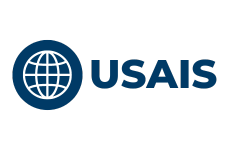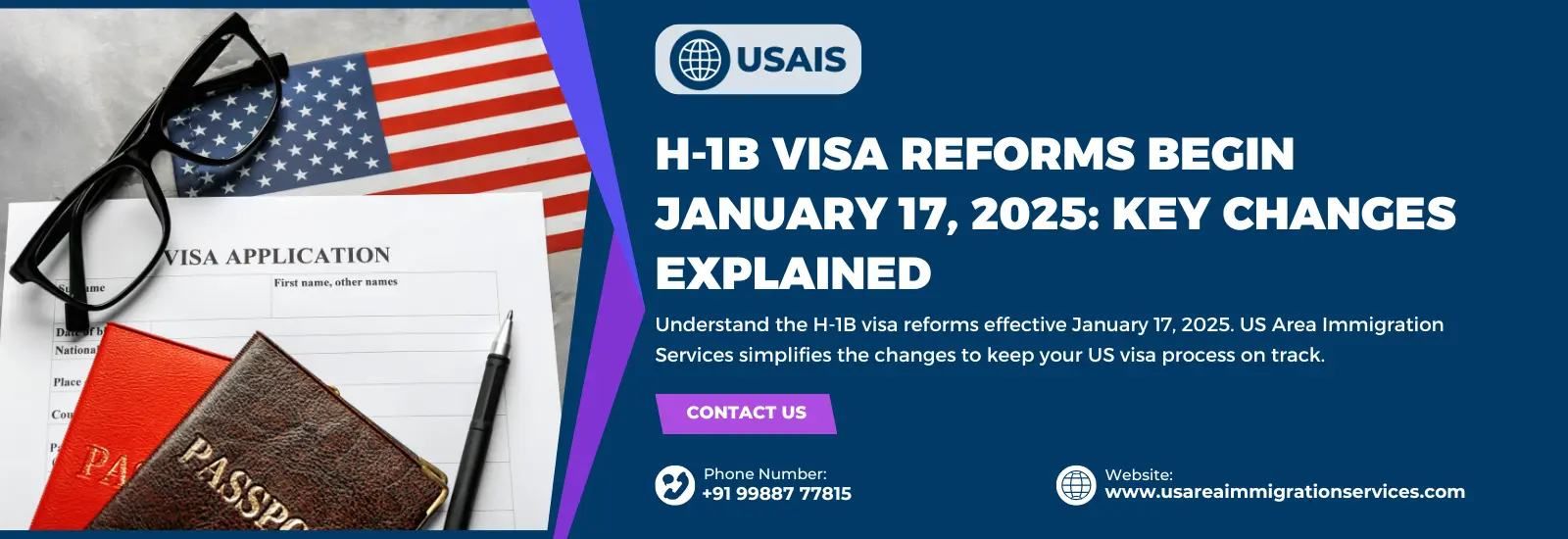The H-1B Visa has been for long the standard means of access to the US labour market for skilled employees with specialized occupations, including computer-related vocations, sciences, engineering, arts, mathematics, astronomy, architecture, engineering, medicine, pharmaceuticals, etc. Still, massive changes to the H-1B visa starting from 17th January 2025 are expected to change the nature of its application, qualifying criteria, and other standard measures to qualify for a visa. They include changes in the visa operating model to increase transparency, assess fairness, and address the workforce in America, safeguarding jobs for Americans.
This detailed guide will be useful to both potential and current H-1B visa applicants as well as employers recruiting international talent after analysing the possible effects of the reforms to be implemented soon.
An Overview of the 2025 H-1B Reforms
The changes introduced by the H-1B visa reforms that are to take effect from January 17, 2025, alter the program in many ways. These altercations intend to solve numerous old problems associated with equality of wages, openness in programs, and workforce formation without compromising the visa system’s compliance with the changing economy of the United States. Below is a detailed overview of the key aspects of these reforms:
Enhanced Eligibility Criteria for Applicants
The change implements greater selectivity for people to be hired and increased requirements concerning the candidates’ qualifications and their relevance to the positions. Notably new is the emphasis on advanced degrees and degrees earned in the United States. This particular shift is to ensure that highly educated human capital remains in the United States while providing stay incentives and bonus pay to graduates in STEM careers. Moreover, the meaning of the term ‘ special occupation’ has been refined to make it harder for all but highly skilled workers to access the program. These changes give CAC additional requirements to qualify for the program, making sure that common non-professional users utilize it but skilled ones only benefit from it.
Stronger Compliance and Enforcement Measures
This section of reforms includes increased measures to prevent some sort of misuse of the H-1B program. Employers are and will be audited regularly, and USCIS will be able to demand Employment Verification Records at any time. Employers are required to keep records of employee remuneration and descriptions of work being performed that codify their H-1B petitions. Such specifications are important to meet because they entail serious consequences, particularly fines and exclusion from further participation in the program. This enhances ethical workforce procurement and also fosters the required merit in the hiring system.
Increased Focus on Workforce Development
Some application fees are likely to be increased, with part of the income channelled towards developing human capital needs. These mechanisms have been intended to build a ready-made force of skilled American workers in every sector where the talent of foreign workers is preferred, such as information technology, health care, and engineering. Despite increasing the ‘formation’ of local talent, the United States government aims to decrease the hiring of H-1B foreigners while enhancing the chances of citizens’ employment. This ensures that the H-1B program is used more like a supplement tool for building local talent rather than being used to replace talent.
Increased Application Fees to Support Oversight
Sponsors of H-1B workers will pay more for their applications, and big companies using lots of foreign talent will pay even more in surcharges. These fee increases are to recover the program’s overheads and finance workforce advocacy for U.S. employees’ projects. Of course, these elevated costs may be somewhat awkward for some employers; still, such measures highlight the government’s willingness to employ foreign talent alongside nurturing homegrown talent. This way not only preserves the H-1B program but also shows the long-term development of American staff in the necessary field.
How These Reforms Impact Stakeholders
The new 2025 H-1B visa offers drastic changes that will shape employers, applicants, and the U.S. workforce. Every team is going to have its prospects and problems it deems crucial to address in response to the new rules. Here’s a detailed look at how the reforms impact key stakeholders:
1. For Employers
Companies depending on the H-1B program to hire foreign talent will be forced to change their staffing and operation models to meet the new rules and requirements.
- Higher Costs: The application fees will be higher, and there will be extra charges if the employer depends on the H-1B employees. Such costs could cause firms to change their business prospects by paying foreigners to work for them. While the bigger companies can afford to bear the costs, the SMEs will likely struggle to meet the costs.
- Enhanced compliance requirements: Employers’ stopping increased requirements for reporting and changes in the regulation of wages and their transparency. This involves reporting specific wages, keeping records of the workforce, and ensuring that the job positions comply with the new standard definition of “speciality occupation.” Failure to do so may lead to auditing, a penalty, or expulsion from the program, among others.
- Focus on skilled roles: The reforms are all built around highly specific career positions, usually with STEM concentrations, and in order to be filled, employers need to target more eligible applicants. Businesses may assume the necessity to adapt their expectations and recruiting standards in order to comprise people who would not have met previous qualifications.
- Investing in Domestic Talent: In order to avoid heavy dependence on foreign talent, employers are expected to support talent development activities like training the American workforce. As this makes the talent pipeline more sustainable, it equally calls for more resources and planning.
2. For H-1B Applicants
The reforms generate new openings, particularly targeting people with high skills while setting higher standards in order to stiffen competition.
- Greater Competition: Special attention is paid to those who have a strong academic background, completed degrees in universities in the USA, and applied for STEM fields. This in turn makes competition for the limited H-1B hotspots stiff, and applicants need to make their portfolio stronger.
- Higher Standards for Eligibility: The new definition of speciality occupation and stricter admission requirements mean that an applicant must prove they are at the pinnacle of their particular career field. Many, especially those applying for less specialized positions or those without the proper educational credentials, may be turned away.
- Improved Wage Protections: The new wage standards guarantee that the H-1B employees get paid rates that are similar to those of an American counterpart. This keeps the applicant from being exploited as well as protects them to ensure they are paid reasonable salaries.
- Enhanced Opportunities for U.S.-Educated Talent: Current international students in U.S. institutions, especially those with postgraduate degrees and in STEM fields, will be boosted by the measures because of better odds of being selected. This is in line with the US government’s policy of keeping such brains within its boundaries once trained.
3. For the U.S. Workforce
The changes are intended to answer the questions of how the program affects domestic employees; they aim to result in a fair system for domestic markets.
- Fair Competition: Higher wage standards would legally maintain the benchmark for hiring H-1B workers at a level that prevents discouraging wages for Americans. This is beneficial to all concerned because it makes the competition more equitable.
- Workforce Development: Some of the raised H-1B fees will help the United States to support certification and training education programs that enhance workers’ skills. These programs were designed so that there is a reduction in the coming years of the reliance on overseas talent, especially in the technological, healthcare, and engineering sectors, due to an elimination of the skills shortage.
- Priority for Domestic Employment: By limiting the ways through which employers can petition for H-1B workers, the reforms ensure that employers fill the position with competent Americans whenever they are available. This way, it guarantees that the program needs to promote the U.S. economy without replacing homegrown talent.
Conclusion
The changes introduced by the H-1B visa reforms that will begin on January 17, 2025, are of a paradigmatic nature for the United States. While wage fairness is beneficial, the other concerns regarding the program are met by improving compliance and by only targeting local talent with an American education to highlight the program’s shortcomings.
Regardless of whether you’re an employer or a wannabe H-1B visa holder, it is high time to get acquainted with these changes with a view to maximizing the available opportunities without running afoul of the law.
Frequently Asked Questions
Ques1. What is the new rule for H-1B visa?
Ans – The rule provides procurement for American workers because it is also meant to improve the H-1B program design by making explicit USCIS’s role in inspecting and punishing those who do not comply with the standard procedures. Employers will be expected to prove the existence of a legitimate position in a speciality occupation from the requested starting date.
Ques2. When to apply for an H-1B visa in 2025?
Ans – To submit an H-1B registration the first step is to have a USCIS online account. The first-time registration for the FY 2025 cycle will begin at 12:00 Eastern on March 6 and end at noon Eastern on March 25.
Ques3. How long can I stay in the US with an H-1B visa?
Ans – The H-1B is a Specialty Occupation work authorization visa for persons whose job it is requires a theoretical knowledge in a specific field of education or special line of work and the program has a maximum cumulative allowed stay of 6 years. The initial period of stay for those in H-1B status is three (3) years, and the period could be further extended to three (3) years subsequently.
Ques4. Can I get a green card after 3 years of H-1B?
Ans – According to the mentioned classification, most of the temporary US visas do not allow the holder to gain permanent residence in the United States. H1B on the other hand is a ‘Dual intent’ visa and the holders of this visa can apply for a Green Card as soon as they attain a maximum of six years.

